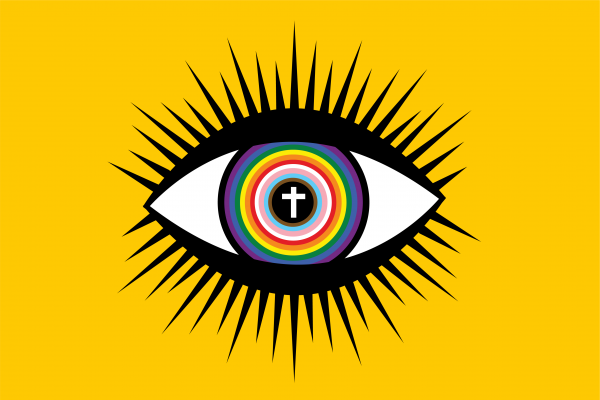This article is part of the series, The Joy of Being Queer and Christian; new articles will be added throughout the month of June.
The first person who names God in the Bible is Hagar, a cast-out enslaved woman who declares that God sees her (Genesis 16:13). She calls God “the one who sees” — the one who notices the invisible, who created the overlooked and called them good. The Bible continues from there, telling of this God who seeks out the forgotten, whether alone in the desert or lost in the crowd.
This is the God who sees me and all on the asexual and aromantic spectrums.
Asexuality and aromanticism describe those whose orientations are often defined by lack and rarity. We’re atypical in that we don’t experience sexual and/or romantic attraction, or when we do, it’s the exception to the rule or under certain conditions.
We’re inconvenient to remember — on all sides of the political and religious spectrums. To those on the Right, we throw a wrench into the narrative that queerness is just about sexual acts. On the Left, we complicate a sex-saturated, “love is love” attitude that too often turns anemic visions of liberation into compulsory sexuality and romance; in either of those spaces, those of us who don’t experience these kinds of attraction are incomprehensible. Christians are often equally unable to imagine a life that is not shaped by romantic and sexual desire: Religious conservatives tell us that we need to “die to the flesh” of our selfishness and embrace the belief that God intended all of us (but especially women) for heterosexual marriage and reproduction; religious liberals often tell us that experiencing sex and romance is required to free ourselves of purity culture.
All these beliefs are examples of amatonormativity, or the expectation that all of us center our lives on a committed romantic and sexual partnership. In both Christian and secular cultures, and in both restrictive conservative and permissive liberal theology, amatonormativity provides strict rules for the idol worship of sex and romance as god; neither route is freedom.
Some asexual people have sex, some aromantic people date, and many of us often carry other labels like bi, pan, gay, or straight for the attractions we do feel. Yet to those who haven’t experienced what we do, we remain unthinkably outside of their norm. We’re heretics to their worldview and their god. And thus, we must be hidden as quickly as possible. In Christian spaces, this impulse to hide the existence of asexual and aromantic people shows up in the way we talk about Jesus’ humanity and temptation: If he was tempted in the ways all humans are, some posit, then he must have experienced romantic and sexual attraction (and possibly relationships) to be fully human — a line of reasoning that implies one must experience romantic and sexual temptation to be fully human. Of course, asked point-blank, most would agree that aromantic and asexual people are no less human. Yet, every sermon, book, and small group study on marriage, dating, and sex furthers that dehumanizing rhetoric, generalizing romantic and sexual attraction (and subsequent temptation) as essential aspects of being human.
Especially within purity culture, Christians emphasize resisting lust and enduring the struggles of waiting until courtship for romance and until marriage to have sex as vital marks of holiness on the path to inevitable marriage. There’s a misconception that purity culture is ideal for aromantic and asexual people, but the key word within purity culture was always waiting: Waiting, not abstaining forever, was the mark of true love — and true love was always defined as romantic and sexual. This flawed theology requires the righteous to suffer through waiting to purify their desire; it idolizes the marital relationship as both an earned reward and a further refining fire necessary for mature spirituality. The metaphor of the church as Christ’s bride is a human concept intended to aid us in understanding God’s commitment and intentionality. But church leaders have twisted this metaphor into a mandate that one must bow to the idol of amatonormativity, following Christ’s example.
Imagine a God who didn’t need a romantic and sexual relationship, whether in the heavens or incarnate here on earth. Imagine a God who told the church to honor singleness so that the people could be freer to serve around the known world. Imagine a God who told the church be a new kind of family that was united not by bloodlines, but by providing for and embracing the orphans, widows, the sick, the abandoned, the meek, and the “least of these.” Imagine a God who made aromantic and asexual people fully human, imago dei, without being defined by the drive for sex and romance.
That’s the God who sees me. A God who creates the tiniest atomic structures and the expanding universe beyond our ability to grasp. A God who made everything in the ocean depths and grew the wildflowers out behind a dumpster, springing up out of concrete, that no one will ever notice. Yes, God’s eye is on the sparrow and the lilies of the field, but also on that which we don’t so easily perceive. The things we avoid seeing. The realities we’d rather not think of as possibilities for us or our children.
I know some people are afraid to see me because they might discover something they don’t want to know about themselves or someone they love. All their lives, they’ve been taught that romance and sex are necessary for being fully human, fully mature, fully normal. And we know that long-prayed-for relationship was assumed to be heteronormative, from the day we’re born, as talk of flirting, crushes, and saving money for a wedding begins.
Yet, God sees the abnormal, weird, even queer. With nearly 500 anti-LGBTQIA+ bills in state legislatures and enough hate to fill the news headlines, there’s plenty to fear about being queer, and there’s a specific grief to being aromantic and/or asexual in the amatonormative society we live in. But we were created good, intentionally, beautifully, and wonderfully — in the very image of the invisible God who sees. With that perspective, my places on the queer, asexual, and aromantic spectrums are gifts, growing and changing as I grow and change.
My word of the year — and what I’m letting myself be — is complicated. Faith requires complications and mysteries, nuanced logic and paradox, simplicity and vastness. My God is big enough to not only tolerate these contradictions and diversity but create and delight in them. I am not lacking, nor am I an issue to debate. I do not need pity, nor am I sick or broken or afraid of love. I am a manifestation of Love’s complex divine revelation, making visible what would otherwise be erased in the billion refractions of rainbow light.
There is much to grieve as queer Christians, and yet there is undaunted joy, because we are not abandoned or alone. We are not invisible after all. We are beloved by the God who sees us, and we will refuse to be hidden any longer, empowered as image-bearers in the church and all the world.
Got something to say about what you're reading? We value your feedback!

